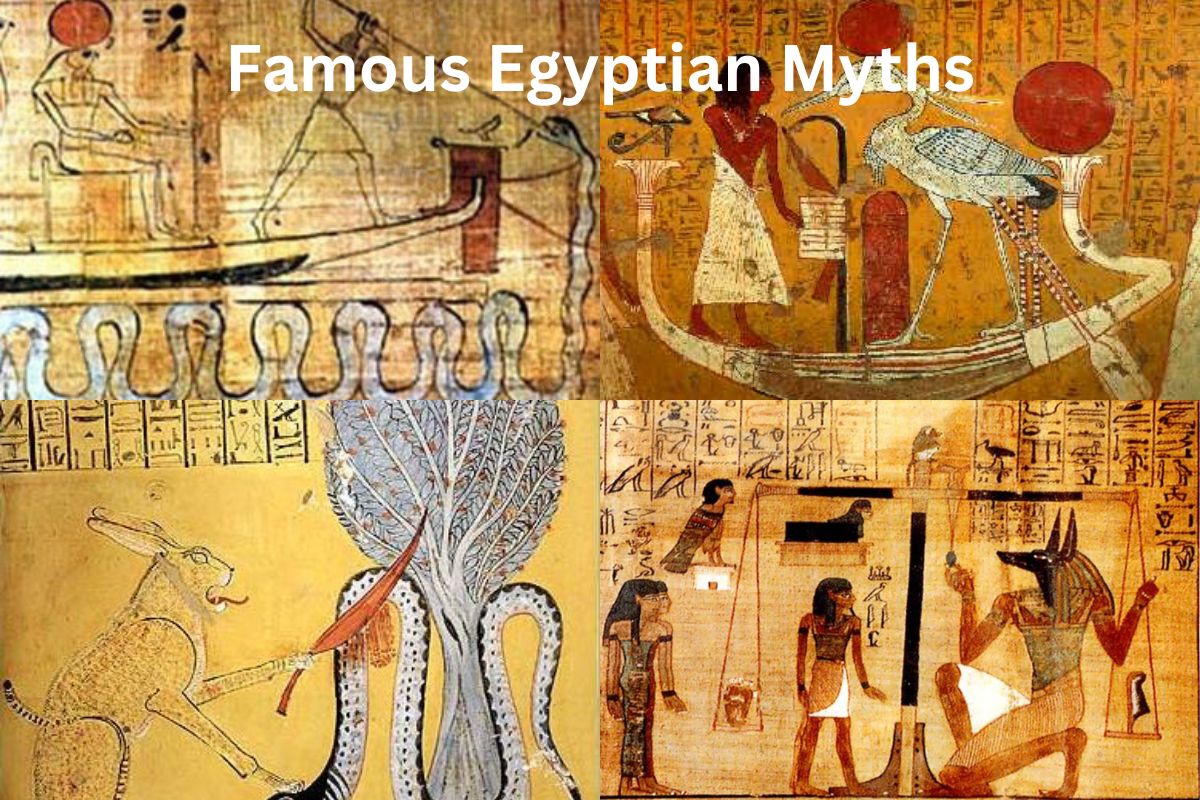Egyptian mythology is one of the oldest and richest mythological traditions in the world. It dates back to ancient Egypt, where it played a central role in religion, politics, and everyday life.
Egyptian myths were used to explain the origins of the world, the relationship between gods and humans, and the afterlife. They featured a diverse cast of gods and goddesses, each with their own unique personalities and powers.
Many Egyptian myths were passed down through oral tradition and were later recorded in hieroglyphic writing. They were often depicted in art and architecture, with intricate carvings and paintings that depicted the gods and their stories.
Some of the most famous Egyptian myths include the creation myth of Ra, the myth of Osiris and Isis, the myth of Horus and Set, and the myth of Anubis and the Weighing of the Heart.
Egyptian mythology continues to be celebrated and remembered in modern times as an important part of Egypt’s rich cultural heritage. It remains a powerful symbol of the enduring power of myth and the human quest to understand the mysteries of the universe.
Famous Egyptian Myths
1. The myth of Osiris and Isis
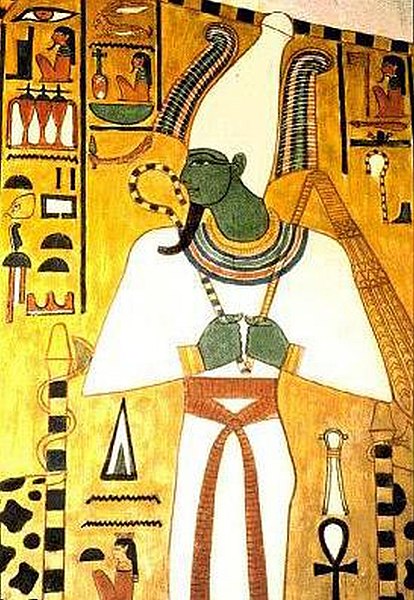
In Egyptian mythology, the narrative of Osiris and Isis is one of the most well-known and revered myths. The myth relates the tale of the Egyptian ruler god Osiris and his wife, the goddess Isis.
Osiris was renowned for his intelligence and generosity, and his people adored him. His brother Set, however, was envious of his authority and attempted to usurp him. Set enticed Osiris into a coffin and hurled it into the Nile, where the current swept it away.
Isis was devastated by the loss of her husband, and she diligently sought for his body. The coffin was eventually discovered in Byblos, a coastal city in modern-day Lebanon, where it had washed up on the shore. Isis returned the body to Egypt and concealed it in reeds along the Nile.
Set discovered the body and dismembered it, distributing the fragments around the area. Yet, Isis persisted in her quest for her husband’s body. She eventually reconstructed Osiris and brought him back to life with the assistance of her sister Nephthys.
Then, Osiris became the deity of the afterlife, ruling over the dead in the underworld. He was also thought to possess the ability to offer eternal life to the deserving.
The tale of Osiris and Isis became a prominent component of Egyptian religion and culture, and was honored across the country with elaborate festivals and rites.
Ancient Egyptians believed that the myth of Osiris’ death and resurrection represented renewal and rebirth, and that it had significant spiritual meaning.
2. The Creation Myth of Ra

The Creation Story of Ra is one of the most significant and intricate Egyptian myths. It describes how the Egyptian god Ra created the universe and all living creatures.
According to the story, darkness and chaos existed in the beginning. Ra, the solar deity, built himself out of this darkness. Then, with the assistance of the god of air, Shu, and the goddess of water, Tefnut, he formed the heavens and the earth.
Ra then created more gods and goddesses, such as Geb, the deity of the earth, and Nut, the sky goddess. Four offspring were born to Geb and Nut: Osiris, Isis, Set, and Nephthys. Osiris became the monarch of Egypt, while Isis, the goddess of magic and fertility, became his wife.
Also Read: Eye of Ra and the Eye of Horus
In addition, the tale describes Ra’s daily voyage over the sky. Ra was thought to ride in his boat during the day, and at night he would enter the underworld to battle and vanquish Apophis, the serpent of chaos, before emerging victorious the following morning.
The Creation Myth of Ra was essential to Egyptian religion and was frequently represented in the country’s art and architecture. It served as a reminder of the gods’ might and capacity to create and control the surrounding universe.
3. The myth of Horus and Seth
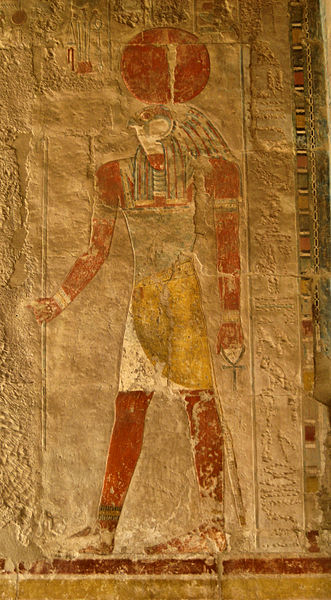
Horus and Set is a well-known Egyptian myth that describes the fight between two strong gods, Horus and Set.
Horus, the son of Osiris and Isis, was the sky deity and monarch of the gods. Set was the deity of disorder and violence, and the desert and storms were frequently connected with him.
The narrative begins with Set, who was envious of his brother’s power and popularity, murdering Osiris. Horus, who was a youngster at the time, resolved to revenge the death of his father and declared war on Set.
Also Read: Seth Egyptian God Facts
The conflict between the two gods was intense and lasted many years. Horus ultimately triumphed and ascended to the throne of Egypt, while Set was exiled to the desert.
Horus and Set’s legend was an integral aspect of Egyptian mythology and was frequently represented in art and literature. It represented the conflict between good and evil and underlined the significance of justice and the rule of law.
In Egyptian society, the tale also functioned as a reminder to kings and authorities that it was their duty to uphold justice and safeguard the populace. The myth of Horus and Set is still honored and remembered as a significant element of Egypt’s rich cultural history in the current era.
4. The myth of Anubis and the Weighing of the Heart
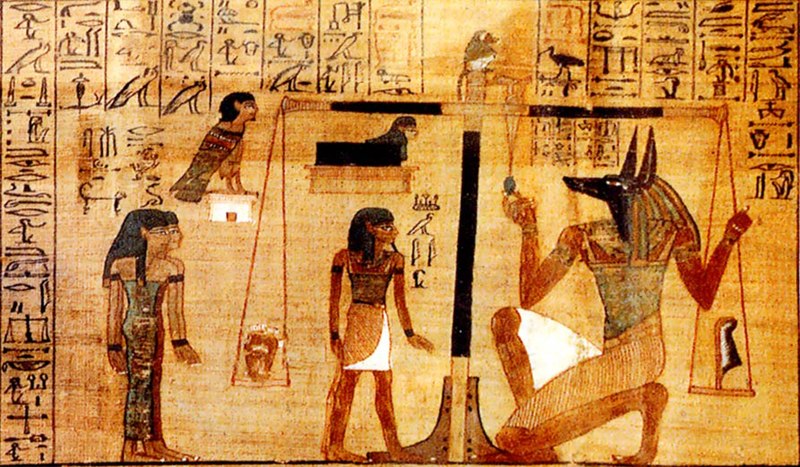
The myth of Anubis and the Weighing of the Heart is a well-known Egyptian myth that describes how the god Anubis assisted in the judgment of the souls of the deceased.
Also Read: Facts About Anubis
According to the story, after death, a person’s soul would be carried by the god Thoth to the Hall of Maat, where it would be judged by a panel of gods, including Anubis. The soul would be weighed against the Maat feather, which represented truth and justice.
If the soul were pure and sinless, it would be permitted to enter the hereafter. But, if the soul was determined to be laden with guilt, it would be devoured by Ammit, a hideous beast comprised of lion, crocodile, and hippos.
Being the deity of embalming and mummification, Anubis played a significant role in the weighing of the heart ceremony. He was accountable for ensuring that the deceased’s body was appropriately maintained and readied for the afterlife.
Ancient Egyptians were reminded by the tale of Anubis and the Weighing of the Heart of the significance of living a good and virtuous life. It also emphasized belief in the hereafter and the notion that one’s acts would be assessed in the afterlife.
The myth of Anubis and the Weighing of the Heart is still revered and remembered as an integral component of Egyptian culture and religion in modern times.
5. The myth of Atum and the creation of the world
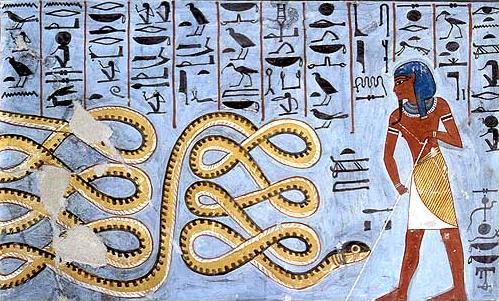
The myth of Atum and the creation of the world is an ancient Egyptian narrative that describes the origin of the universe and all living beings.
Before the world existed, there was only darkness and chaos, according to the story. In the beginning, Atum dwelt by himself in the primordial seas of Nun.
Atum desired to create the world, so he utilized his own might and spoke his name to make himself. His offspring, Shu and Tefnut, became the gods of air and water, respectively.
Atum despatched Shu and Tefnut into the darkness to explore and gain information. When they returned, they brought Geb, who became the god of the ground, and Nut, who became the goddess of the sky.
Four offspring were born to Geb and Nut: Osiris, Isis, Set, and Nephthys. Osiris became the monarch of Egypt, while Isis, the goddess of magic and fertility, became his wife.
The myth of Atum and the birth of the universe was central to Egyptian religion and was frequently represented in art and literature. It highlighted the concept of creation by spoken word and the gods’ ability to create life from the universe’s turmoil.
The narrative of Atum and the creation of the world continues to be treasured and remembered as a significant aspect of Egypt’s rich cultural history in current times.
6. The myth of Bastet and the destruction of Apep
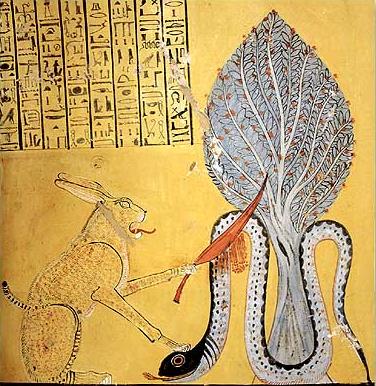
The tale of Bastet and the destruction of Apep is a well-known Egyptian myth that recounts how the goddess Bastet aided in the downfall of the snake god Apep, who was believed to have brought chaos and disaster to the universe.
According to the tale, Apep was a mighty serpent god who threatened to consume Ra every day as he traveled through the underworld. To prevent this from occurring, the Egyptian gods and goddesses waged a daily war against Apep, led by Set.
During one of these encounters, Bastet, the goddess of cats, aided in Apep’s defeat by utilizing her powers. She assumed the form of a lioness and attacked the serpent, shredding him to pieces and scattered his bones over the underworld.
Also Read: Bastet Goddess Facts
Then, Bastet was revered as a guardian of the gods and goddesses, and she became identified with the sun and the moon. She was also believed to have the ability to defend people from harm and repel evil.
The myth of Bastet and the defeat of Apep had a significant role in Egyptian religion and was frequently represented in art and literature. It underlined the significance of cooperation and teamwork in fighting the forces of disorder and evil in the world.
The narrative of Bastet and the death of Apep is still revered and remembered as a significant element of Egypt’s rich cultural legacy in modern times.
7. The myth of Sekhmet and the end of humanity
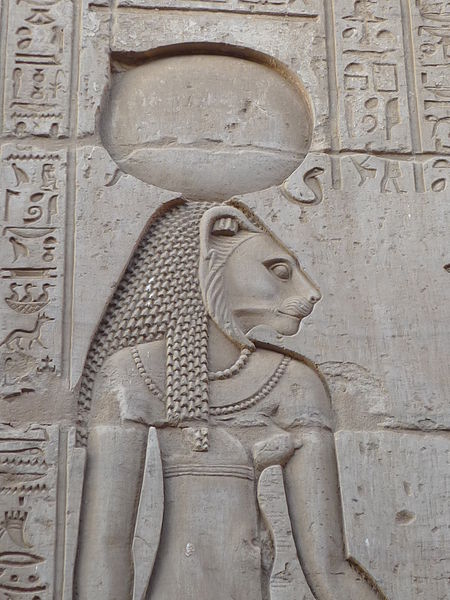
The myth of Sekhmet and the death of humanity is a well-known Egyptian fable that describes how the goddess Sekhmet nearly wiped out humanity.
According to the tale, Ra, the sun god, became angry with humanity for disobeying his commandments and intended to punish them by sending a formidable goddess. He created Sekhmet, a strong and powerful goddess with a lion’s head, and sent her to earth to destroy all people.
Also Read: Sekhmet Facts
Sekhmet went on a fury and began randomly murdering humanity. She relished the bloodshed and was progressively out of control. Concerned by her behavior, the other gods and goddesses decided to interfere.
The gods devised a plan to deceive Sekhmet by making a massive amount of red beer and spilling it on the ground. When she believed it to be blood, Sekhmet drank it all and became so intoxicated that she passed out.
While she slept, the gods were able to restore her sanity by transporting her back to heaven. In order to balance Sekhmet’s ferocity, they invented another goddess, Hathor, who was the more benign element of Sekhmet.
The myth of Sekhmet and the end of humanity served as a cautionary tale about the risks of unbridled rage and the significance of maintaining a healthy life balance. In addition, it highlighted the gods’ and goddesses’ ability to intercede in human affairs.
The narrative of Sekhmet and the end of humanity is still revered and remembered as a significant element of Egypt’s rich cultural history in modern times.
8. The myth of Thoth and the invention of writing
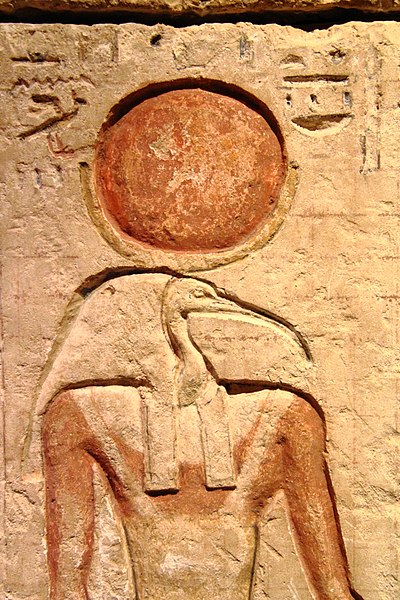
The myth of Thoth and the invention of writing is a well-known Egyptian legend that describes how the god Thoth invented the hieroglyphic writing system.
According to the story, Thoth was the god of intelligence and knowledge, and he was renowned for his language and communication skills. Ra, the god of wisdom, contacted him one day and requested him to design a system of writing that could be used to preserve and communicate essential information.
Also Read: Thoth Facts
Thoth established the hieroglyphic writing system, which employed images and symbols to represent words and concepts. This technique was then introduced to the Egyptians, who utilized it to record everything from religious texts to historical documents.
In Egyptian culture, the story of Thoth and the advent of writing highlighted the significance of knowledge and communication. In addition, it underlined the gods’ ability to bestow significant blessings upon humanity.
The hieroglyphic writing system remained in use in Egypt for thousands of years, and its influence on human culture and history has endured. It is still studied and admired as one of the earliest and most intricate writing systems ever invented.
9. The myth of the Bennu bird and the Phoenix
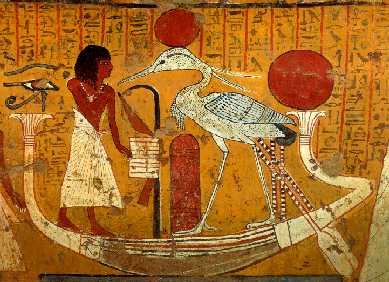
In ancient Egyptian mythology, the myth of the Bennu bird and the Phoenix narrates the narrative of a sacred bird that was regarded as a symbol of rebirth and renewal.
According to legend, the Bennu bird lived for 500 years before constructing a nest of cinnamon and myrrh twigs. The bird would then put itself and the nest on fire, and a new Bennu bird would emerge from the ashes, prepared to live for another 500 years.
Later, the Greeks identified the Bennu bird with the Phoenix, which likewise possessed the ability to resurrect. According to the Greek story, the Phoenix would live for 500 years before constructing a nest of twigs and setting it on fire. A fresh Phoenix would emerge from the ashes, ready to live for another 500 years.
Both the Bennu bird and the Phoenix were associated with the sun, as it was believed that they rose with the sun each morning and flew over the sky. They were also believed to have the power to bring new life and vitality to the Earth, as they were identified with Ra, the sun deity.
The tale of the Bennu bird and the Phoenix highlighted the cyclical cycle of life as well as the significance of renewal and rebirth. It served as a reminder to the ancient Egyptians and Greeks of the gods’ ability to bring about transformation and change in the world.
Nowadays, the legend of the Bennu bird and the Phoenix remains a significant component of human culture and mythology. It continues to inspire and captivate people throughout the world as a potent symbol of hope and renewal.
10. The myth of the god Ptah and the creation of the world through thought and speech
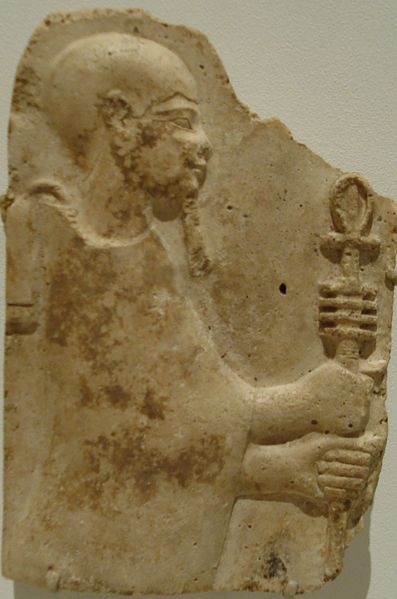
The legend of the Egyptian god Ptah and the conception of the world through intellect and language.
In ancient Egyptian mythology, the narrative of the deity Ptah and the creation of the universe by thought and speech describes how the world and all living things were created through the power of language and mind.
According to the story, darkness and chaos existed in the beginning. But then the deity Ptah appeared, and with the strength of his intellect and speech, he was able to construct the world.
Ptah was commonly associated with the creation of art and beauty, as he was regarded as the deity of artisans and craftsmen. Ptah created the universe, the stars, the earth, and all living things, including humans, with his mental and verbal abilities.
According to the myth, Ptah spoke the universe into being by pronouncing the words that brought everything into existence. This notion of creation via language and thought was essential to Egyptian religious beliefs, and it served as a reminder of the power of words and the significance of language to human society.
The creation of the world and the tale of Ptah highlighted the significance of creativity and the arts in human life. In addition, it underlined the gods’ ability to create and change the world around us.
The story of Ptah and the creation of the world through thought and speech continues to be celebrated and remembered as a significant aspect of Egypt’s rich cultural heritage in the modern era.
11. The myth of Ra and the serpent Apep
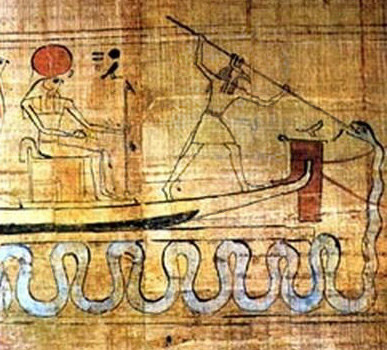
The fable of Ra and the serpent Apep is a well-known Egyptian myth that describes how the sun god Ra fought every night with the serpent Apep to ensure that the sun would rise each morning.
According to the myth, Apep was a powerful serpent deity who resided in the underworld and embodied destruction and chaos. Each night, Apep would attack Ra’s boat, which carried the sun through the underworld, to prevent the sun from rising.
Ra, the sun god and king of the gods, fought Apep every night with the assistance of other gods, such as Set, who was connected with the desert and storms. The battle between Ra and Apep was intense and lasted all night.
To aid Ra in battle, the Egyptians would build wax representations of Apep and then melt them in the sun, signifying the victory of order over chaos.
The legend of Ra and the serpent Apep served as a reminder of the world’s ongoing conflict between good and evil. It also stressed the gods’ power and ability to establish order in the universe.
The narrative of Ra and the serpent Apep is still revered and remembered as a significant element of Egypt’s rich cultural history in current times. It continues to inspire and captivate people throughout the world as a potent representation of the unending conflict between light and darkness.
12. The Legend of the Sun Boat
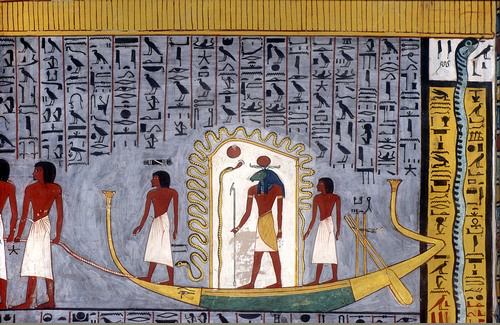
The Tale of the Sun Boat is an ancient Egyptian myth that describes the sun deity Ra’s trip across the heavens in a boat.
Ra, according to the tale, was the sun deity and monarch of the gods. Daily, he would board the Sun Boat and travel across the sky, bringing light and warmth to the planet.
It was reported that the Sun Boat was a gorgeous vessel with golden sails and an ebony and ivory hull. It was manned by the Egyptian gods and goddesses who accompanied Ra on his trip across the sky.
As it traversed the sky, the Sun Boat would face numerous obstacles, including attacks from the serpent deity Apep, who was believed to bring catastrophe. To defend the Sun Boat, the gods and goddesses would employ their powers to vanquish Apep and secure Ra’s uninterrupted travel.
Ra would enter the underworld at the conclusion of each day to relax and prepare for the next day’s journey. On his travels, Ra was thought to have brought light and life to all living creatures.
The Tale of the Sun Boat served as a reminder of the sun’s strength and its significance to all life on Earth. It also underlined the cyclical cycle of life, as the sun rose each morning and set each evening.
Today, the tale of the Sun Boat is still revered and remembered as a significant element of Egypt’s illustrious cultural heritage. It continues to be a potent emblem of the gods’ ability to bring light and life to the world.
13. The Legend of the Sphinx
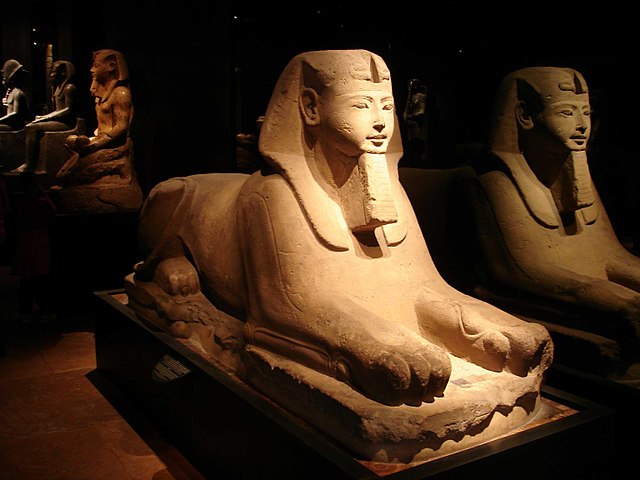
The Legend of the Sphinx is a famous Egyptian myth about a creature with the head of a human and the body of a lion. According to the myth, the Sphinx was said to have been sent by the sun god Ra to guard the entrance to the city of Thebes.
The Sphinx was said to pose a riddle to all those who approached it, and anyone who could not answer the riddle would be killed. The riddle was, “What walks on four legs in the morning, two legs in the afternoon, and three legs in the evening?” The answer was a human, who crawls on all fours as a baby, walks on two legs as an adult, and uses a cane in old age.
The myth goes that a young prince named Oedipus came upon the Sphinx while traveling, and he was asked the riddle. Oedipus was able to answer correctly, which angered the Sphinx, causing it to kill itself in despair. In some versions of the myth, the Sphinx was said to have been turned to stone by the gods after Oedipus solved the riddle.
The Sphinx became a symbol of wisdom and power in ancient Egypt and has been depicted in art and architecture for thousands of years. The Great Sphinx of Giza, which stands near the Pyramids of Giza, is one of the most famous examples of the Sphinx in Egyptian art and is one of the largest statues in the world.
